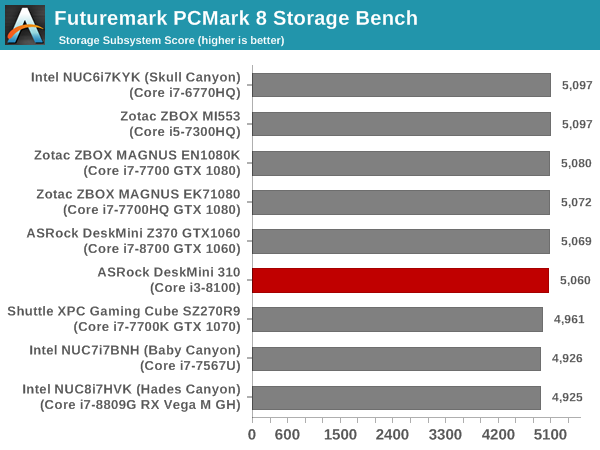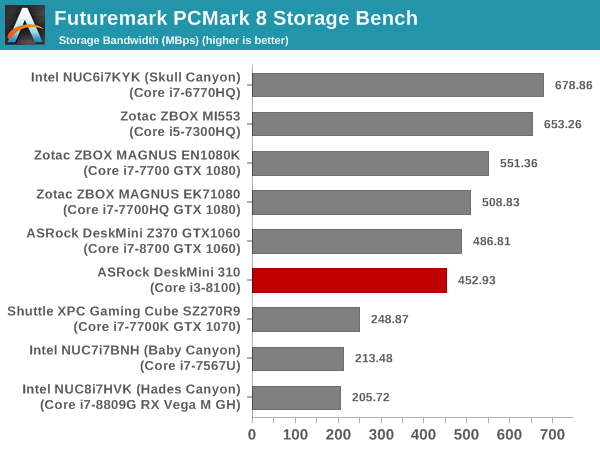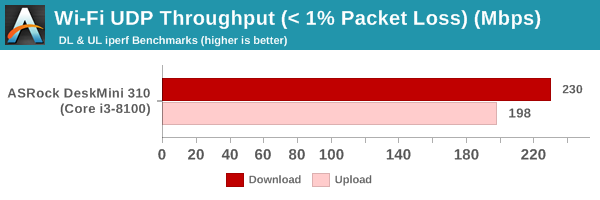The ASRock DeskMini 310 Mini-PC Review: A Cost-Effective Mini-STX Platform
by Ganesh T S on March 15, 2019 9:30 AM ESTNetworking and Storage Performance
Networking and storage are two major aspects which influence our experience with any computing system. This section presents results from our evaluation of these aspects in the ASRock DeskMini 310. On the storage side, one option would be repetition of our strenuous SSD review tests on the drive(s) in the PC. Fortunately, to avoid that overkill, PCMark 8 has a storage bench where certain common workloads such as loading games and document processing are replayed on the target drive. Results are presented in two forms, one being a benchmark number and the other, a bandwidth figure. We ran the PCMark 8 storage bench on selected PCs and the results are presented below.


The NVMe SSD used in the DeskMini 310 allows it to be clear of the SATA-using PCs in the above graphs. However, the 240 GB capacity point and general performance prevent the drive from moving up the graph.
On the networking side, we restricted ourselves to the evaluation of the WLAN component. Our standard test router is the Netgear R7000 Nighthawk configured with both 2.4 GHz and 5 GHz networks. The router is placed approximately 20 ft. away, separated by a drywall (as in a typical US building). A wired client is connected to the R7000 and serves as one endpoint for iperf evaluation. The PC under test is made to connect to either the 5 GHz (preferred) or 2.4 GHz SSID and iperf tests are conducted for both TCP and UDP transfers. It is ensured that the PC under test is the only wireless client for the Netgear R7000. We evaluate total throughput for up to 32 simultaneous TCP connections using iperf and present the highest number in the graph below.

In the UDP case, we try to transfer data at the highest rate possible for which we get less than 1% packet loss.

These bandwidth numbers are consistent with what one can expect from a 1x1 client radio.










48 Comments
View All Comments
ciparis - Friday, March 15, 2019 - link
For SFF machines like this, the industry standard I/O backplane needs to be replaced with a much more modern solution, sized appropriately for modern ports. Such an eyesore and a terrific waste of space.Death666Angel - Friday, March 15, 2019 - link
"waste of space" What would you put there to use up the space? It seems to me that the cooler might interfer with higher stacks of sockets.Hixbot - Friday, March 15, 2019 - link
You really need to add noise measurements to your SFF reviews.zodiacfml - Saturday, March 16, 2019 - link
The STX form factor will become more interesting in the years to come, considering Intel's tech roadmap (better integrated graphics, 3D chip stacking).zodiacfml - Saturday, March 16, 2019 - link
Forgot the most important, 10nm chips which could allow 10core CPUs in 65w TDPLord of the Bored - Saturday, March 16, 2019 - link
Assuming Intel ever figures out how to make chips in quantity again. I can't decide if the ongoing supply issues are sad, funny, or a sinister ploy to get people used to higher processor prices in advance of a new suggested retail cost plan.ajp_anton - Saturday, March 16, 2019 - link
I have a question about these "65W max" motherboards. What limitations have they put in place for 95W CPUs? Does the BIOS simply reject them, or will it fry the board at some point? I was thinking if it's possible to plug in a 95W -K processor but undervolt and underclock it so that it stays within 65W, but hopefully at a higher frequency than a stock 65W CPU thanks to the manual undervolting.ajp_anton - Saturday, March 16, 2019 - link
Especially since that 65W CPU never really uses 65W anyway. With a -K CPU it might be possible to create your own custom CPU that hits 65W max.MoreloveXXX - Sunday, March 17, 2019 - link
A real man will find a girl in a couple of minutes. =>> http://newgirlworld.gaThe_Assimilator - Sunday, March 17, 2019 - link
"The enabling of the M.2 SSD slot with PCIe lanes directly from the CPU gets around the bandwidth constraints imposed by the PCIe 2.0 links in the H310 PCH."Not like there's anything else to use those lanes... it would've been a massive waste if ASRock *hadn't* used the CPU PCIe lanes for something.